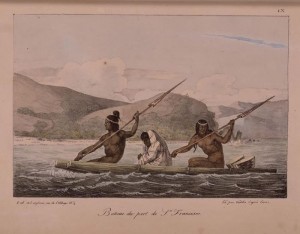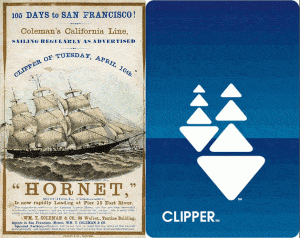 Canoes were among the first maritime vessels in the Bay Area. Beginning 8,000 years ago, Miwoks and Ohlones thatched together reedy tule plants from the marshes to build vessels by which they could hunt, fish, and trade along the inland waterways and the coastal areas of the Pacific Ocean.
Canoes were among the first maritime vessels in the Bay Area. Beginning 8,000 years ago, Miwoks and Ohlones thatched together reedy tule plants from the marshes to build vessels by which they could hunt, fish, and trade along the inland waterways and the coastal areas of the Pacific Ocean.
Europeans likely first “discovered” the San Francisco Bay by caravel in 1542, but countervailing winds, thick fog, and the death of expedition leader Juan Cabrillo discouraged more Spanish from following. Sir Francis Drake passed by what might have been the San Francisco Bay in 1579, but whatever he found was so obscured by fog that subsequent voyages couldn’t find it again. Europe gave up searching for over 200 years. The Spanish didn’t arrive and stay in the San Francisco Bay area until 1769.
Over the next several decades, San Francisco’s bay and inland waterways became active trading ports. In the late 1700s, the San Francisco Bay was the meeting place for traders from the United States, Mexican California, and the nearby Russian settlements in Sonoma County. Eventually, traders from China came to San Francisco Bay on their way to Monterey Bay.
Then in 1848, gold was discovered in Coloma, northwest of Sacramento. In the 1849 over 62,000 people arrived in San Francisco by boat. Hundreds of the boats were left in the Bay – abandoned by new gold prospectors off to find their treasures inland. When prospectors failed to find gold, they became settlers, and new local businesses thrived. The wood from many of these abandoned ships were used to build new homes in San Francisco. The population of future-San Francisco exploded from 8,000 in 1846 to about 120,000 in 1850. San Francisco replaced Monterey as California’s official port of entry.
 San Francisco’s port came into vogue just as the new fast and sleek clipper ships were breaking speed records in the 1850s. The clipper ship’s likeness bears a striking resemblance to the Clipper Card logo.
San Francisco’s port came into vogue just as the new fast and sleek clipper ships were breaking speed records in the 1850s. The clipper ship’s likeness bears a striking resemblance to the Clipper Card logo.
When the first Transcontinental Railroad was completed in 1869, the need to ship goods between U.S. coasts declined, but international trade kept the port strong. As the City of San Francisco continued to grow, the interior of the San Francisco Bay began to attract development.
In 1895, Augustin S. Macdonald visited Point Richmond and conceived the idea of a new transcontinental rail terminal and ferry service to provide a direct route from Richmond to San Francisco. In 1899 the railroad established its new terminus in Point Richmond. The first overland passenger train arrived in Richmond from Chicago in 1900. In 1901, Santa Fe moved its base to Richmond.
During World War II, large shipyards in both San Francisco and Contra Costa County constructed hundreds of naval ships. Manufacturing and port industries were important economies to many cities along the San Francisco Bay shoreline. One of those shipyards is now home to the Rosie the Riveter/World War II Home Front National Historical Park.
Today, San Francisco and Oakland ports combined are the third largest U.S. port on the west coast.
